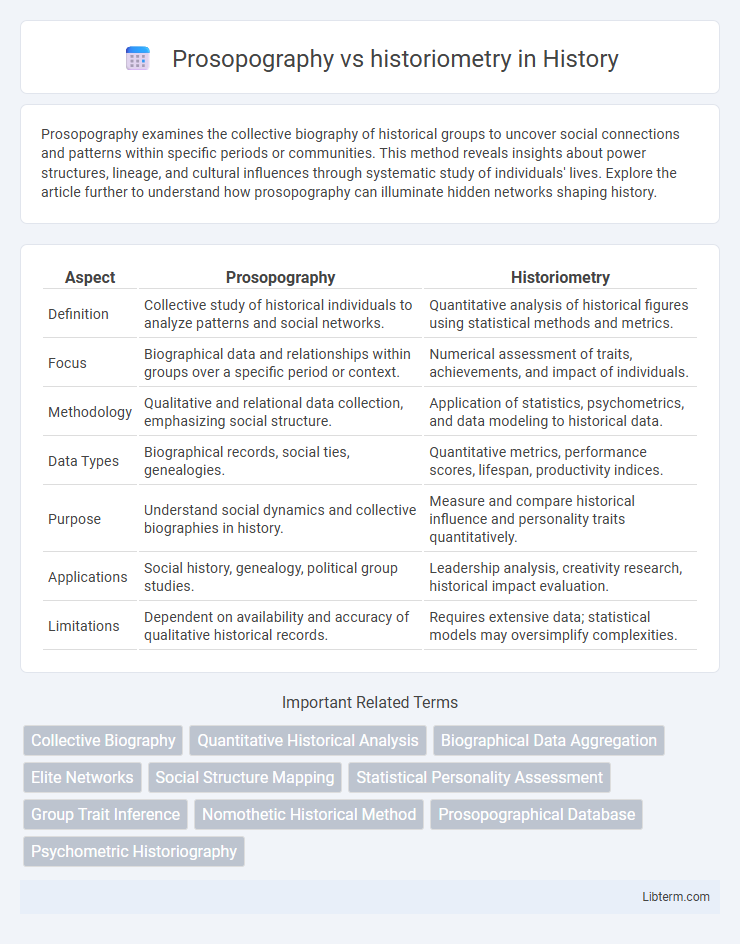Prosopography examines the collective biography of historical groups to uncover social connections and patterns within specific periods or communities. This method reveals insights about power structures, lineage, and cultural influences through systematic study of individuals' lives. Explore the article further to understand how prosopography can illuminate hidden networks shaping history.
Table of Comparison
| Aspect | Prosopography | Historiometry |
|---|---|---|
| Definition | Collective study of historical individuals to analyze patterns and social networks. | Quantitative analysis of historical figures using statistical methods and metrics. |
| Focus | Biographical data and relationships within groups over a specific period or context. | Numerical assessment of traits, achievements, and impact of individuals. |
| Methodology | Qualitative and relational data collection, emphasizing social structure. | Application of statistics, psychometrics, and data modeling to historical data. |
| Data Types | Biographical records, social ties, genealogies. | Quantitative metrics, performance scores, lifespan, productivity indices. |
| Purpose | Understand social dynamics and collective biographies in history. | Measure and compare historical influence and personality traits quantitatively. |
| Applications | Social history, genealogy, political group studies. | Leadership analysis, creativity research, historical impact evaluation. |
| Limitations | Dependent on availability and accuracy of qualitative historical records. | Requires extensive data; statistical models may oversimplify complexities. |
Introduction to Prosopography and Historiometry
Prosopography systematically analyzes collective biographies to uncover patterns within historical groups, emphasizing relationships, social status, and career trajectories. Historiometry quantitatively assesses historical figures using statistical methods to measure traits such as leadership qualities and intellectual influence. Both methods enrich historical research by combining qualitative contextualization with quantitative analysis to interpret past behaviors and societal trends.
Defining Prosopography: Scope and Methodology
Prosopography involves the systematic study of collective biography by analyzing the common characteristics of a historical group through the aggregation of individual data points such as social status, careers, and familial relationships. Its scope covers populations ranging from political elites to social classes within specific timeframes, employing methodologies like database compilation, statistical analysis, and pattern recognition. This approach contrasts with historiometry, which quantifies historical figures' achievements and influence through statistical metrics rather than focusing on group characteristics and social structures.
Historiometry Explained: Purpose and Techniques
Historiometry is a quantitative method that analyzes historical data to measure psychological and social traits of individuals or groups using statistical techniques and archival sources. Its purpose is to uncover patterns in leadership, creativity, and decision-making by combining psychological theory with empirical historical evidence. Techniques include content analysis, frequency counts, and correlation studies that transform qualitative historical records into measurable variables.
Historical Development of Prosopography
Prosopography emerged as a methodological tool in the 19th century, primarily to systematically analyze collective biographies and social structures within historical populations. Unlike historiometry, which applies quantitative analysis to individual achievements and traits, prosopography focuses on patterns and relationships across groups to illuminate social networks and institutional dynamics. Its development involved the compilation of extensive biographical databases, facilitating the study of elite populations and bureaucratic organizations in ancient and medieval history.
The Evolution of Historiometry in Historical Research
Historiometry has evolved from rudimentary quantitative analyses into sophisticated statistical methods that quantify historical figures' influence and achievements through measurable data such as correspondence patterns, publication records, and documented impact metrics. In contrast to prosopography, which emphasizes collective biographical details for social and relational patterns, historiometry applies rigorous mathematical models and computational tools to extract objective insights about leadership effectiveness, creativity, and historical significance. The integration of big data analytics and digital archives has propelled historiometry's role in historical research, enabling large-scale, data-driven evaluations that complement traditional qualitative narratives.
Key Differences Between Prosopography and Historiometry
Prosopography systematically analyzes collective biographical data to identify patterns within historical groups, emphasizing social structures and networks. Historiometry employs quantitative methods and statistical analysis to study historical figures' traits or achievements, often aiming to measure influence or greatness. The key difference lies in prosopography's focus on group characteristics through qualitative and relational data, while historiometry centers on numerical evaluation of individual historical impact.
Comparative Applications in Social Science Research
Prosopography examines collective biographies to identify patterns within historical groups, while historiometry employs quantitative methods to measure individual historical figures' traits and achievements. Comparative applications in social science research leverage prosopography to analyze social structures, networks, and class dynamics, whereas historiometry focuses on personality assessment, leadership effectiveness, and creativity metrics. These methodologies complement each other by integrating qualitative group analysis with quantitative individual evaluation for comprehensive historical insights.
Strengths and Limitations of Prosopographic Methods
Prosopography excels in revealing collective patterns and social networks by systematically analyzing groups through shared characteristics and biographical data, enabling historians to understand social structures and relationships over time. Its strength lies in aggregating large datasets to identify trends that individual narratives may overlook, but it faces limitations such as potential bias from incomplete records and the challenge of accurately interpreting statistical correlations without contextual nuances. Unlike historiometry, which quantitatively assesses individual achievements and psychological traits, prosopography emphasizes group analysis, making it less effective for understanding singular historical figures' personal motivations.
Advantages and Challenges of Historiometric Analysis
Historiometric analysis offers precise quantitative evaluation of historical figures by applying statistical methods to biographical data, enabling insights into personality traits, leadership qualities, and career achievements. Advantages include the ability to handle large datasets for empirical validation and uncover patterns across time, while challenges involve potential biases in historical records, data incompleteness, and difficulties in standardizing diverse qualitative information. Despite these issues, historiometry remains a powerful tool for systematically studying influential individuals and comparing historical impact objectively.
Future Trends: Integrating Prosopography and Historiometry
Future trends in historical research emphasize integrating prosopography and historiometry to enhance data-driven analysis of individual and group behaviors over time. Combining prosopographical databases with historiometric methods enables scholars to uncover complex social networks and quantify historical figures' impact more accurately. Advances in big data analytics and machine learning are expected to drive this interdisciplinary approach, offering richer insights into sociopolitical dynamics and historical event causality.
Prosopography Infographic

 libterm.com
libterm.com